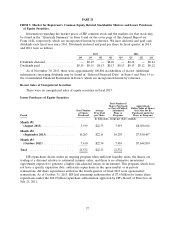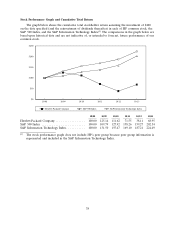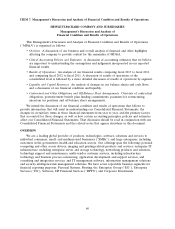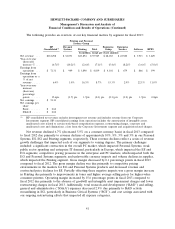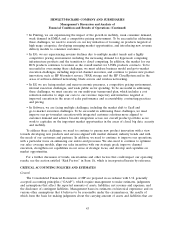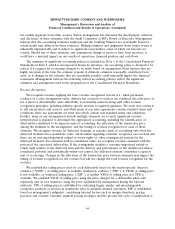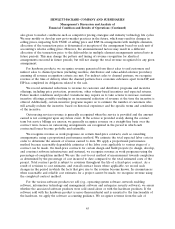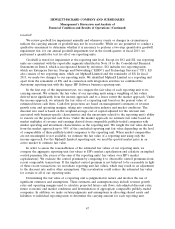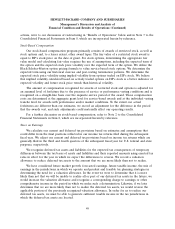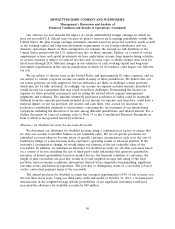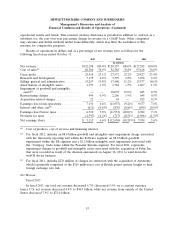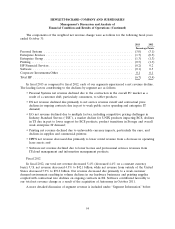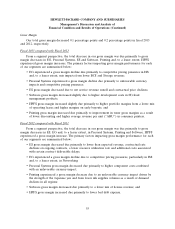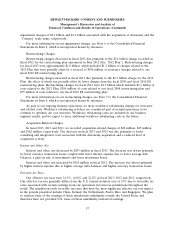HP 2013 Annual Report Download - page 55
Download and view the complete annual report
Please find page 55 of the 2013 HP annual report below. You can navigate through the pages in the report by either clicking on the pages listed below, or by using the keyword search tool below to find specific information within the annual report.HEWLETT-PACKARD COMPANY AND SUBSIDIARIES
Management’s Discussion and Analysis of
Financial Condition and Results of Operations (Continued)
Goodwill
We review goodwill for impairment annually and whenever events or changes in circumstances
indicate the carrying amount of goodwill may not be recoverable. While we are permitted to conduct a
qualitative assessment to determine whether it is necessary to perform a two-step quantitative goodwill
impairment test, for our annual goodwill impairment test in the fourth quarter of fiscal 2013, we
performed a quantitative test for all of our reporting units.
Goodwill is tested for impairment at the reporting unit level. Except for EG and ES, our reporting
units are consistent with the reportable segments identified in Note 18 to the Consolidated Financial
Statements in Item 8, which is incorporated herein by reference. EG includes two reporting units,
which are Enterprise Servers, Storage and Networking (‘‘ESSN’’) and Technology Services (‘‘TS’’). ES
also consists of two reporting units, which are MphasiS Limited and the remainder of ES. In fiscal
2013, we made two changes to our reporting units. We identified MphasiS Limited as a reporting unit
apart from the remainder of ES, and in connection with integration activities we combined the
Autonomy reporting unit with the legacy HP Software business reporting unit.
In the first step of the impairment test, we compare the fair value of each reporting unit to its
carrying amount. We estimate the fair value of our reporting units using a weighting of fair values
derived most significantly from the income approach and to a lesser extent the market approach. Under
the income approach, we estimate the fair value of a reporting unit based on the present value of
estimated future cash flows. Cash flow projections are based on management’s estimates of revenue
growth rates and operating margins, taking into consideration industry and market conditions. The
discount rate used is based on the weighted-average cost of capital adjusted for the relevant risk
associated with business-specific characteristics and the uncertainty related to the reporting unit’s ability
to execute on the projected cash flows. Under the market approach, we estimate fair value based on
market multiples of revenue and earnings derived from comparable publicly-traded companies with
similar operating and investment characteristics as the reporting unit. We weight the fair value derived
from the market approach up to 50% of the concluded reporting unit fair value depending on the level
of comparability of these publicly-traded companies to the reporting unit. When market comparables
are not meaningful or not available, we estimate the fair value of a reporting unit using only the
income approach. For the MphasiS Limited reporting unit, we used the quoted market price in an
active market to estimate fair value.
In order to assess the reasonableness of the estimated fair values of our reporting units, we
compare the aggregate reporting unit fair values to HP’s market capitalization and calculate an implied
control premium (the excess of the sum of the reporting units’ fair values over HP’s market
capitalization). We evaluate the control premium by comparing it to observable control premiums from
recent comparable transactions. If the implied control premium is not believed to be reasonable in light
of these recent transactions, we reevaluate reporting unit fair values, which may result in an adjustment
to the discount rate and/or other assumptions. This reevaluation could reduce the estimated fair value
for certain or all of our reporting units.
Determining the fair value of a reporting unit is judgmental in nature and involves the use of
significant estimates and assumptions. These estimates and assumptions may include revenue growth
rates and operating margins used to calculate projected future cash flows, risk-adjusted discount rates,
future economic and market conditions and determination of appropriate comparable publicly-traded
companies. In addition, we make certain judgments and assumptions in allocating shared assets and
liabilities to individual reporting units to determine the carrying amount for each reporting unit.
47


